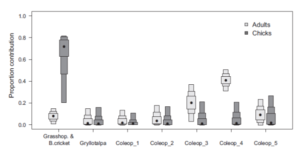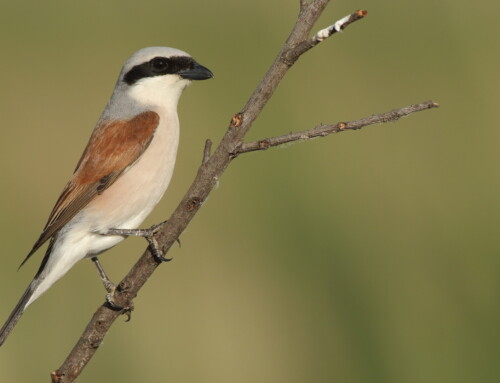LINKED PAPER
Combining stable isotope analysis and conventional techniques to improve knowledge of the diet of the European Roller Coracias garrulus. Catry, I., Sampaio, A., Silva, M.C., Moreira, F., Franco, A.M.A. & Catry, T. 2019. IBIS. DOI: 10.1111/ibi.12625. VIEW
Assessing the diet of birds can be challenging. The choice of method, each with specific advantages and drawbacks, depends on the questions being asked and needs to consider the variation across species, seasons, and between sites, sexes or age groups and even between individuals.
In this study, we aimed to investigate the diet of the European Roller, Coracias garrulus, through the breeding period in Portugal. To study the diet of adults, we first decided to use pellets collected in different nest-sites. But pellets from chicks are hard to use due to tramping in the nests, making individual pellets impossible to analyse. Thus, we used small video-recording cameras installed near nest entrances to allow the identification of prey items delivered to chicks.

Figure 1 Rollers are sit-and-wait predators that use perch sites to scan for prey © Inês Catry
How can we study the diet of different age or sex groups? In most cases, the conventional diet assessment methods (e.g. analysis of regurgitated pellets and video recordings) do not allow to assess within-species differences in diet due to the impossibility of drawing the link between dietary remains and particular individuals. Recently, the use of stable isotopes analysis (SIA), in particular of carbon (δ13C) and nitrogen (δ15N), allowed a relevant advance in studies of avian trophic ecology (Hobson & Clark, 1992; Bearhop et al., 2004). Stable isotope analysis provides information on food sources that have been incorporated into an animal’s tissues (e.g. blood) over. The shift in isotope ratio between diet and consumer tissue is known as the trophic enrichment factor (TEF) and can be used in isotopic mixing models to quantify the relative contributions of isotopically distinct food sources to species’ diet.
After describing sexual and parental-offspring dietary segregation in Lesser Kestrels, Falco naumanni (Catry et al. 2016), we wanted to investigate the diet of both adult (females and males) and nestling Rollers and compare the results given by SIA and conventional methods.
In total, we identified 1417 prey items consumed by adult Rollers from 84 pellets analysed, representing at least 43 different taxa. Adults feed mainly on hard-bodied insects, with beetles (Coleoptera) representing approximately 84% of all items consumed. Dung (Scarabeidae), leaf (Chrysomelidae) and ground (Carabidae) beetles made the greatest contribution to the diet of adult Rollers. Analysis of camera images enabled identification of 345 prey items from 19 nests. In contrast to adults, nestling diet was dominated by grasshoppers and bush crickets (Orthoptera), which accounted for 74.2% of all prey delivered. Coleoptera represented only 7.5% of all prey identified, although this value may be underestimated given that 12.2% of prey delivered were small and could only be identified as ‘non-Orthoptera’ and were likely to include Coleoptera.

Figure 2 Adult Roller delivering a bush-cricket to the offspring. Image captured by a small camera attached to the nest-box to study the diet of nestlings
To investigate sexual and age differences in the diet of Rollers we took blood samples from 15 males and 20 females (adults) and 15 nestlings and also collected several main prey species found inside or near the nests. Carbon and nitrogen isotopic signatures of Rollers and their prey were then assessed.
Our results suggest no sex-specific diet segregation in Rollers, as we found no differences in d13C and d15N ratios of blood between males and females during the mate feeding and incubation periods, with females showing only a slightly wider isotopic niche than males. Trophic sexual segregation can arise to reduce intra-specific competition between males and females, especially in species showing sexual size dimorphism, or when males and females play different roles during reproduction. However, Rollers show few sex-specific morphological and plumage traits (field-identification of sex is difficult), making niche specialization driven by sexual size dimorphism unlikely. Moreover, after egg-laying, both sexes incubate the eggs, brood and feed the young, and in contrast to Lesser Kestrels, where females are preferentially fed with higher energy prey (mole crickets) during the courtship period, resulting in sexual diet segregation (Catry et al. 2016a), male Rollers do not seem to feed their mates with different prey than those consumed by themselves.

Figure 3 Hatchling Roller and eggs © Inês Catry
On the other hand, blood ratios of carbon stable isotopes suggest some degree of diet segregation between parents and offspring, as also suggested by comparing the results from pellets and video recording. We believe that, as suggested for Lesser Kestrels (Catry et al. 2016), adult Rollers may feed their offspring a higher proportion of soft- bodied grasshoppers and bush crickets than prey consumed by themselves given the relatively large size, higher digestibility and high energetic value of these prey when compared with hard-bodied, smaller and thus less profitable prey, such as Coleoptera.

Figure 4 Relative contribution of prey in the diet of adult and nestling Rollers as estimated by SIAR mixing models. Black dots represent the mode and boxes present the 50, 75 and 95% credible intervals
Blood isotopic signatures of adult and nestling Rollers confirmed the results obtained through pellet and video-recording techniques. Of the three methods, pellet analysis provided the most comprehensive trophic information regarding the detectable prey spectrum and prey species contribution, as well as basic diet information for the SIA. Overall, we showed that the combination of different methods could be used to gain new and clearer insights into avian trophic ecology that are essential for informing habitat management aiming to improve availability of foraging resources.
Nominate this article for a BOU Science Communication Award.
References
Bearhop, S., Adams, C.E., Waldron, S., Fuller, R.A. & Macleod, H. 2004. Determining trophic niche width: a novel approach using stable isotope analysis. J. Anim. Ecol. 73: 1007-1012. VIEW
Catry, I., Catry, T., Alho, M., Franco, A.M.A. & Moreira, F. 2016. Sexual and parent–offspring dietary segregation in a colonial raptor as revealed by stable isotopes. J. Zool. 299: 58-67. VIEW
Hobson, K.A. & Clark, R.G. 1992. Assessing avian diets using stable isotopes 2. Factors influencing diet-tissue fractionation. Condor 94: 189-197. VIEW
Image credit
Featured image: European Roller, Coracias garrulus © Teresa Catry




